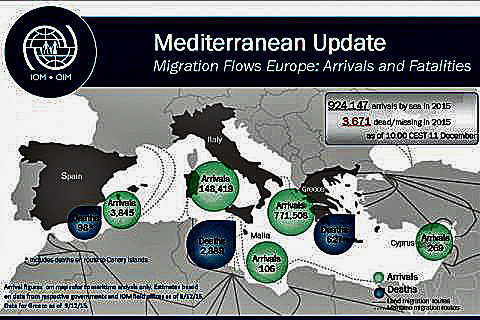PBS: Escaping Eritrea … [Read More...] about ካብ ውሽጢ ቤት ማእሰርታት ኤርትራ
Patrick Kingsley, Migration correspondent |
"We don't take sides; we help you see more sides."

Published:
PBS: Escaping Eritrea … [Read More...] about ካብ ውሽጢ ቤት ማእሰርታት ኤርትራ
Patrick Kingsley, Migration correspondent |
International Organisation for Migration announces latest figures, with Greek island of Lesbos now the main refugee gateway
Out of a total of 1,005,504 arrivals by 21 December, the vast majority – 816,752 – arrived by sea in Greece, the IOM said. A further 150,317 arrived by sea in Italy, with much smaller figures for Spain, Malta and Cyprus. A total of 34,215 crossed by land routes, such as over the Turkish-Bulgarian border.
The overall figure is a four-fold increase from 2014’s figures, and has largely been driven by Syrians fleeing their country’s civil war. Afghans, Iraqis and Eritreans fleeing conflict and repression are the other significant national groups.
The European migration flow is nevertheless far more manageable than in the Middle East, where roughly 2.2 million Syrian refugees live in Turkey alone. In Lebanon, 1.1 million Syrians form about one-fifth of the country’s total population, while Jordan’s 633,000 registered Syrian refugees make up around a tenth of the total.
The denial of basic rights to refugees in those countries, where almost all Syrians do not have the right to work, is one of the causes of Europe’s migration crisis. Refugees who have lived for several years in legal limbo are now coming to Europe to claim the rights bestowed on them by the 1951 UN refugee convention.“In Jordan, life is so difficult,” said Nemer, a 24-year-old Syrian student, minutes after landing this week on the Greek island of Lesbos. “There’s no [legal] work. I can’t go to university. There’s no hope. And in Turkey it’s the same thing: no work and no hope.”
Other refugees are fleeing directly from the war zones themselves. Aruba al-Rifai, a 44-year-old civil servant from the outskirts of Damascus, arrived on Lesbos this week having come straight from Syria. “The bombs are getting worse, and it’s just the beginning,” said Rifai. “I come to Europe to feel like a human being.”
Among rights workers, Tuesday’s news prompted renewed calls for Europe to set up safe and legal access to refugees. Save the Children, which says that over a quarter of refugee arrivals to Europe this year have been minors, said the absence of a more humanitarian response meant that the values of the continent were now at risk.
“Despite many European countries and people generously helping one million refugees, Europe is doing too little to protect and help vulnerable refugee children and stop families drowning on our shores,” said Kirsty McNeill, the charity’s campaigns director.
“This is the test of our European ideal. When children are dying on our doorstep we need to take bolder action. There can be no bigger priority.”

Among other demands, McNeill also called for better provision for refugees once they arrive in Europe. “Some reception facilities, especially at borders, aren’t adequately providing for basic needs like food, water or healthcare,” McNeill said in a statement. “The situation is expected to worsen with the onset of winter – especially for children -who are also more vulnerable to abuse, exploitation, violence and trafficking. We urge European states to focus on immediate humanitarian needs on the ground, especially for children.”
The record movement of people into Europe is a symptom of a record level of disruption around the globe, with numbers of refugees and internally displaced people far surpassing 60 million, UNHCR said last week.
“I don’t understand why people are insisting that this is a European problem. This is a global issue,” Michael Moller, director of the UN office in Geneva, told a news conference on Tuesday.
The UN refugee chief Antonio Guterres called on Friday for a “massive resettlement” of Syrian and other refugees within Europe, to distribute many hundreds of thousands of people before the continent’s asylum system crumbles.
He called for European countries to recognise the positive contributions made by refugees and migrants and to honour what he said were “core European values: protecting lives, upholding human rights and promoting tolerance and diversity.”
Lesbos is now the main refugee gateway to Europe, with just under half of those entering the continent in 2015 doing so by using the island as a staging post between the Greek mainland and the nearby shores of Turkey. Despite the worsening weather, and despite a so-called crackdown on Turkey’s people-smugglers, the numbers arriving in December are still higher than in June and July. Over 15 boats arrived on Lesbos on Monday. Across the Greek islands, the average number of refugees arriving each day in December is 3,338, lower than the October peak of 6,828, but far higher than July’s 1,771.
The IOM data is the latest in a slew of different and sometimes contradictory figures being used to quantify the European migration crisis. Other sources include the UN refugee agency, which is not publicly monitoring land arrivals; Frontex, the EU border agency, which sometimes double-counts people; and Eurostat, the EU’s statistics agency, whose data conflates numbers from the refugee crisis with those that refer to internal European migration.
Between 12 and 14 million Europeans are estimated to have been displaced in the aftermath of the second world war.